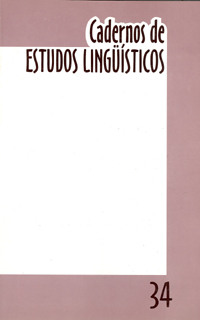Resumo
O Aguaruna é uma língua da família lingüística Jívaro falada por aproximadamente 45 mil índios localizados na região Norte da Amazônia Peruana. O Aguaruna, segundo as suas características morfossintáticas, pode ser considerado como língua predominantemente SOV e em termos das suas relações gramaticais como nominativo-acusativa. Como toda língua natural, o Aguaruna, além de ser basicamente SOV, apresenta variações do tipo SVO e OVS, variações consideradas nas previsões de Steele (1978). Para essa autora, línguas SOV podem variar entre OSV, SVO, OVS, VSO e VOS. No caso do Aguaruna, as variações mais freqüentes, a partir da ordem SOV, são SVO e OVS.Referências
CORBERA MORI, Angel. Fonologia e Gramática do Aguaruna. Tesis de Doctorado en Ciências. Campinas, SP: IEL-UNICAMP, 1994
CROFT, William. Typology and Universals. Cambridge: CUP, 1990
DRYER, M.S. Object-Verb order and Adjective-Noun order: dispelling a myth. Lingua 74; 1988: 185-217.
______. On the Six-Way word order typology. Studies in Language 21(1); 1997: 69-103
GREENBERG, Joseph H. Some universals of Grammar with Particular Reference to the Order of Meaningful Elements. In: J.H. Greenberg, ed. Universals of Language. Cambridge, Mass.: MIT Press, 1963: 73-113
FAST, G. & LARSON, M.L. Introducción al idioma Aguaruna. Pucallpa,Peru: MEC-ILV, 1974
HAWKINS, John A. Word Order Universals. New York: Academic Press, 1983
LARSON, M.L. La estructura del texto Aguaruna. In: Ågot Berli, org. Estudios lingüísticos de textos de la Amazonía Peruana. Serie Lingüística Peruana 37. Pucallpa, Peru: MEC-LIV, 1996: 157-220.
LEHMANN, Winfred. A structural principle of language and its implications. Language, 49(1); 1973: 47-66
PALMER, F. R. Grammatical roles and relations. Cambridge: CUP, 1994
ROSS, John Robert. Gapping and the order of constituents. In: M. Bierwisch & K.E. Heildolph, eds. Progress in Linguistics. The Hague: Mouton, 1970: 249-259
STEELE, Susan. Word order variation: a typological study. In J.Greenberg et alii, eds. Universals of Language, vol. 4. Syntax, 1978: 585-623
TRAVIS, Lisa. Parameters and effects of word order variation. Ph. D. Dissertation. MIT, 1984
VENNEMANN, T. Topics, subjects, and word order: from SXV to SVX via TVX. In: J.M. Anderson & J.C. Jones Historical Linguistics v.1. Amsterdam: North-Holland Pub. Co.; 1974: 339-376.
O periódico Cadernos de Estudos Linguísticos utiliza a licença do Creative Commons (CC), preservando assim, a integridade dos artigos em ambiente de acesso aberto.

